A short, pleasant train ride later (really, just like every train ride we ever took in Japan) we arrived at Nara station. Our first impression of Nara certainly belied the history held within the boundaries of the city. On its face, Nara is a modernist concrete and asphalt city that doesn’t seem to be up to delivering the glorious temples and World Heritage sites as promised. However, by this time we had become well used to Japan swaddling phenomenal temples and cultural sites inside drab, functional cities, so we were relatively unfazed by the fact that we didn’t trip over a temple getting off the train. What did get my ire to some degree was, once again, misleading guidebook descriptions creating false expectations. You would think that a place described as a “slice of ancient Japan” would not look like a Tokyo suburb, but apparently that would be incorrect. Oh well, nothing to do but move forward!
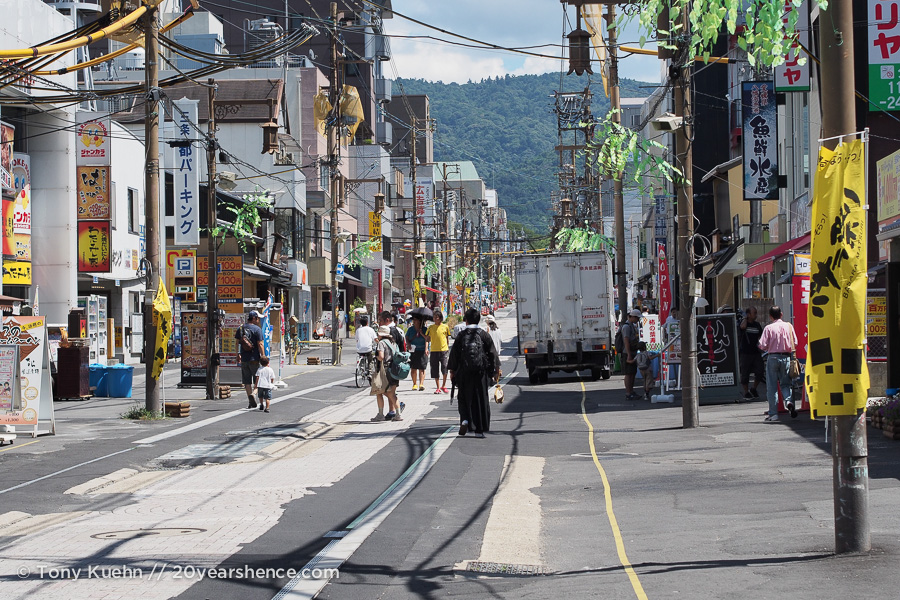
Heading down the main street from the station, our primary mission was to find some lunch before we got down to any serious temple gazing. There was a shopping arcade filled with restaurants rumored to be about halfway down the street, so we wiped the sweat from our brows and plunged ahead. Once more, expecting a line of historic buildings, old neighborhoods of wooden houses, or anything to suggest “old Japan,” we were presented with rows of modern, functional, concrete buildings.
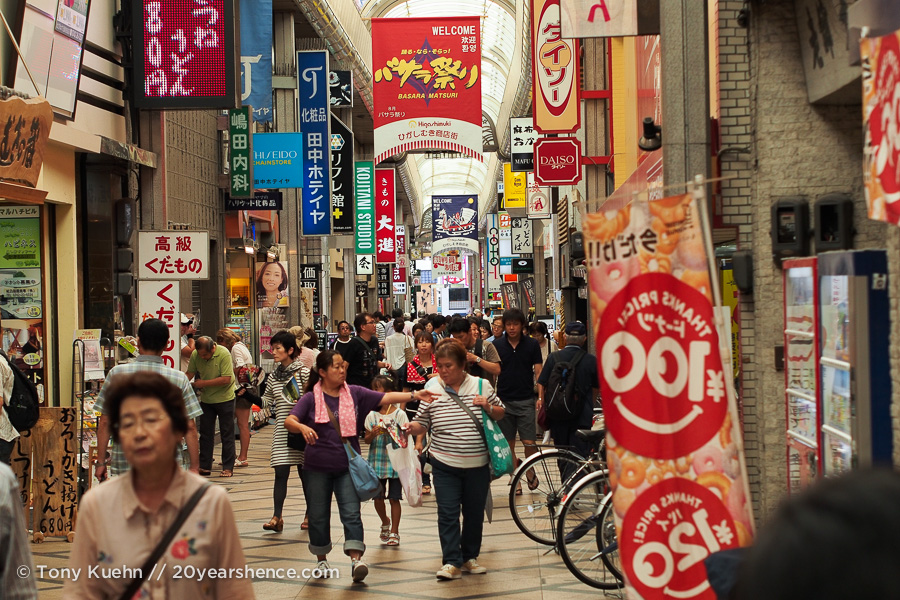
The heat in Nara was certainly more bearable than previous cities in Japan, but seeing as this was still August it was by no means cool. By the time we got to the decidedly modern shopping arcade, we were getting pretty hot and hungry and were more than ready for our lunch. Unfortunately, the two choices we had in mind were not to be found, so we stopped into a random tonkatsu restaurant and tried to put our new “big lunch, small dinner” plan into action. Since lunch is almost always cheaper than dinner, we figured it was the right time to fill up, not discounting the fact that eating a smaller dinner is better for your waistline as well.
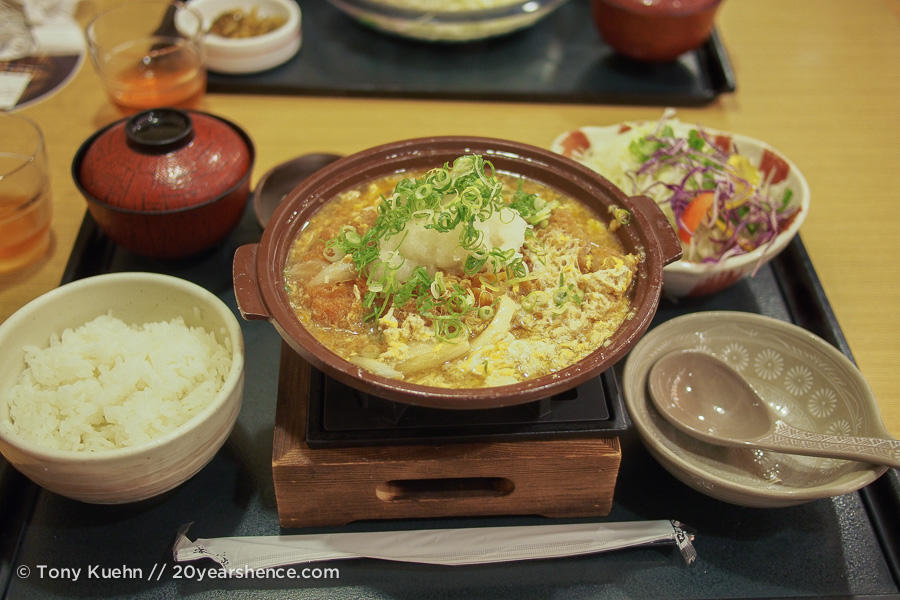

After a delicious lunch, we started up the street again, looking now for the tourist information center to see if we could get a map and some directions. All the way up the road we had noticed obvious preparations for some sort of festival, so when we finally came to the information desk we asked about the festival as well. The helpful woman behind the desk lit up, telling us all about the modern dance festival known as Basara Matsuri and asked us how we had heard about the festival. Well, apart from the shiny new fans we had been given after our meal, and the legion of workers in the street, we hadn’t. She seemed a little confused by our confession, as apparently the festival is an enormous draw for Nara, and she had simply assumed we were there for some Japanese modern dance. Learning the festival would start in the late afternoon, we figured we would probably see some of the action as we headed back to the station.
A little further up the street the road splits and to the right there is a little pond and a snack shop where you can buy bread to feed the many turtles slowly paddling around the brackish, green water below. As it turns out, this also takes you away from the park, and the rather unhelpful map doesn’t do a lot to get you back. After some head scratching and slight wandering, we saw the park and were back on course again, even if we did enter from an odd angle and somehow managed to miss the main gate on our way in.
Nara park is aptly named. It’s a park, through and through. It has some lovely landscaping, myriad walking paths and copious trees. Even some benches, a rare sight in this sitting-averse country. Set within this park is an array of temples, shrines, gardens and ponds and a veritable army of deer. Legend would have it that the god of the Kasuga Taisha rode a white deer, so our modern deer enjoy protected status as godly envoys. To quote some wit on wikitravel: “…either the deer have lost the job, or the god has taken an extremely passionate interest in biscuits from tourists (¥150), empty food wrappers and harassing shopkeepers.” Ha! Truer words are rarely spoken, thanks internet! Though, this is not to be dismissive of the deer, no indeed! In fact, they were likely our favorite part of Nara.
The deer are beyond docile, however unlike the deer in Miyajima, they are a bit standoffish at first. This is quick to pass though, as the moment you make a move towards one of the stations that sell deer crackers you find yourself surrounded by 25 of the best friends you’ve ever known. The deer are nothing if not canny, and this extends to their behavior when proffered crackers. ¥150 buys a good amount of crackers, and the experience of having a deer oh-so-gently remove a cracker from between your fingers really never gets old. The only minor hazard is that the fat ones get a little greedy and will push the less assertive deer out of the way, but with a little scolding all is well.
The Japanese fear of docile creatures large and small seems to be alive and well in Nara, as I witnessed a grown man buy a package of crackers, get gently swarmed by friendly deer, only to immediately panic, backpedal and throw all the crackers on the ground, giving the confused deer as much space as possible. The horrified look on his face told the whole story: he had barely survived. This was only topped by the groups (!) of people in the Kyoto metro who fled shrieking from what had to be the world’s most dangerous moth. I won’t say this fear is ubiquitous, but it certainly seems all too common.
After a delightful interlude feeding deer, we decided that we should probably see some sights, despite being tempted to call our visit a success and head home. Our first stop was Todai-ji, home to one of the biggest Buddhas on Earth, and the largest in Japan. The statue is enclosed in what is said to be the world’s largest wooden structure. Perhaps the layout of the interior threw us, or the scale of the Buddha compared to the building created some optical illusion, but we felt that the outdoor Buddha in Kamakura was more impressive.


Outside the massive gates, to the temple we were served our first taste of some modern Japanese dance and chalked up our lack of enthusiasm to cultural differences, although the Super Mario Brothers sound effects were a nice, albeit bizarre, touch.

We then wended our way through the park, generally heading for Kasuga Taisha, which we had heard was just lousy with stone lanterns and not to be missed. It seems that the designer of this particular temple was a bit of a tease, only loosely sprinkling lanterns along the shaded path to the temple in slowly growing numbers. Just as Steph was beginning to doubt the hype, we rounded a corner and it seemed the wait paid off: the path simply exploded with lanterns, hundreds of them in every direction. Large, small and everything in between — the sight was impressive. I can only imagine these all lit up at night, it would be nothing short of extraordinary. The temple itself was very nice, though we arrived slightly too late to enter. Famous for its wisteria, the temple’s attendant young ladies wore a unique headdress that paid homage to the plant.

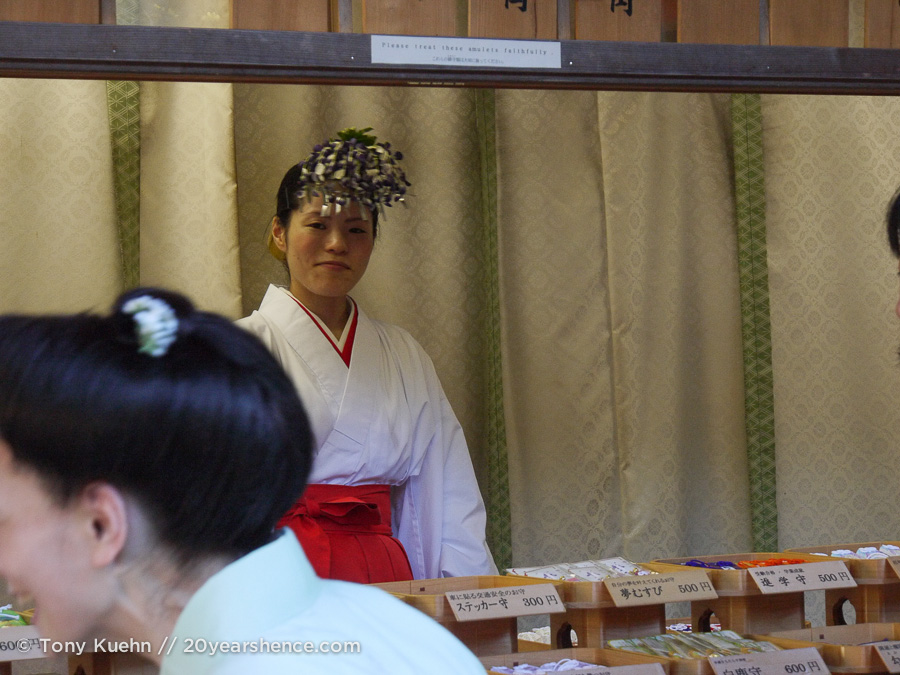
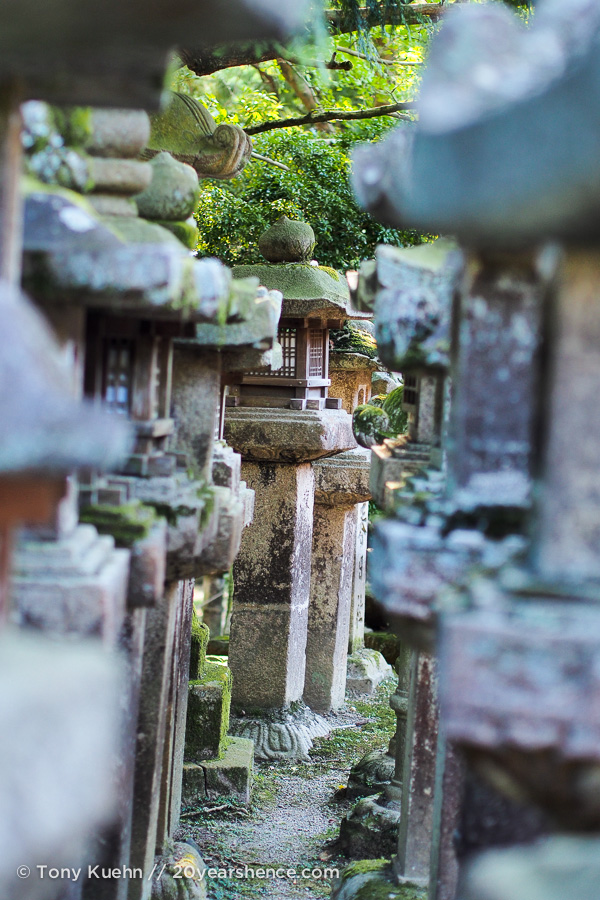
Our last destination of the day was surely our favorite: Ukimido, a hexagonal pagoda set on a serene lake. It’s said the pagoda is meant to look as though it is floating on the water, and while we didn’t pick up on this particular illusion, it in no way reduced our enjoyment of the place. Totally at peace, enjoying the last rays of the afternoon, we sat and soaked up the tranquility and beauty all around us and thanked our lucky stars that we found our way here, despite the crummy, not to scale map of the grounds.
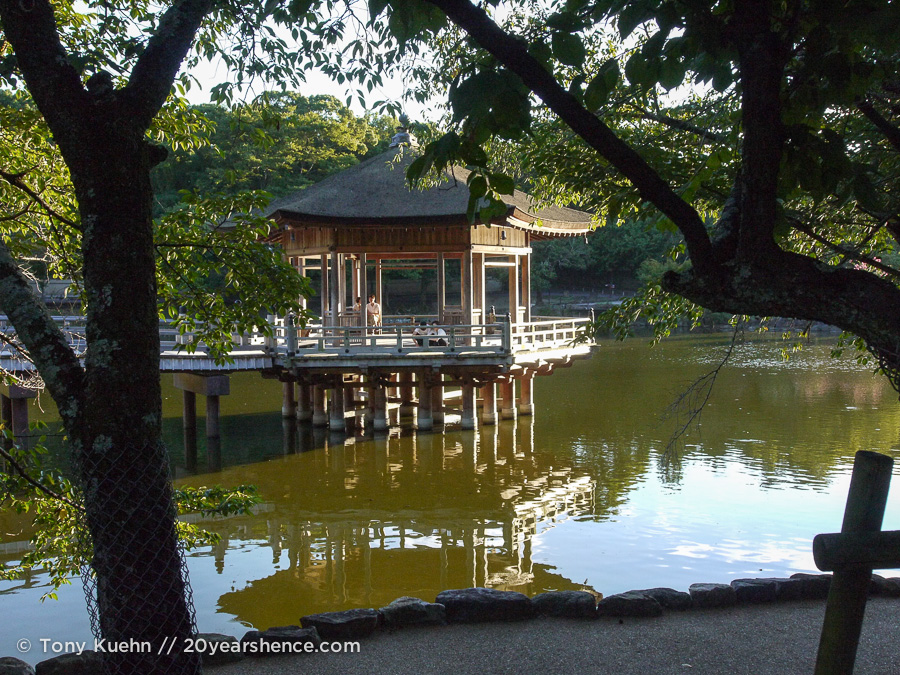
On our way out of the park we walked back down the main road to the train station and passed through throngs of people lining the streets as a slow moving procession of revelers moved up the road towards the park. Each line of dancers was lead by a truck with an elevated platform where an emcee shouted over a PA system and ran the music. Overall, the dancing and music was not to our taste with a line of taiko drummers being our favorite act, though not as impressive as their counterparts in Matsumoto. Moving on after a few displays, we boarded a train for Kyoto and headed home for the night.

As we rode the train back to the city, we spent some time breaking down our day in Nara. Had it been worth it to come? Honestly, we weren’t really sure. Nearly everything we saw in Nara was done better somewhere else in Japan. Kamakura’s big Buddha (diabutsu) seemed a better bet to us, Kanazawa’s garden was nicer than Nara’s park, Nikko’s temples were more beautiful than anything on the grounds. Overall, Nara just seemed like a place you would go if you missed the other, better parts of Japan. For us, the best part of the day by far was the deer. If you want to have some encounters with friendly, albeit very greedy deer, Nara is a safe bet. Though, to be fair, Miyajima’s deer are friendlier, their affections don’t cost money and they come with an island that is more interesting and prettier than Nara.

Bottom line? Come to Nara if your time in Japan is limited and you want a quick and easy day-trip from Kyoto. If you want a taste of what the country has to offer, you can get it here. But, if you’re like us, and have some time to spend, save the time in Nara for somewhere better.
The photos of Nara are so beautiful!! Still kicking myself that this was the one place I missed in Japan that I REALLY wanted to get to. Next time!
Don’t feel too bad, there are so many wonderful things to see and do in Japan, it could fill a lifetime. If Nara is all you ever miss in Japan, then you are still doing really well.
We really liked Nara – it might be because it was so early in the trip and we hadn’t seen all the temples yet…still, awesome! And oh yeah, the deer of course – so cute, nice pics.
It’s not that Nara isn’t likable, or even that it’s bad, really. It’s just that Japan set such a high standard everywhere else that Nara seemed to wilt a little in comparison, for us at least. In retrospect, something in Japan that is only so-so is still better than a lot of things elsewhere in the world. Japan spoils you that way.
Ah!! Nostalgia! Nara was just fantastic. I was there for a day and my Blogger friends showed me around. It was fantastic 🙂
So glad you enjoyed it! Nara certainly has its charms, and I can imagine that it would be even more interesting with a qualified guide 🙂